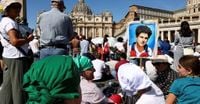On Sunday, September 7, 2025, the Catholic Church made history by canonizing Carlo Acutis, a 15-year-old Italian computer whiz, as its first millennial saint. The ceremony, held in St. Peter’s Square at the Vatican and attended by an estimated 80,000 people, marked a significant moment for a faith community seeking to bridge the gap between ancient tradition and modern life. Alongside Acutis, another young Italian, Pier Giorgio Frassati—known for his devotion to the poor and his untimely death from polio at age 24—was also declared a saint in a vibrant, youth-filled celebration led by Pope Leo XIV, the first American pontiff.
Carlo Acutis’ story is one that resonates deeply with a generation raised on the internet. Born in London on May 3, 1991, to a wealthy but not particularly religious family, Acutis moved to Milan as a child, where he enjoyed a seemingly ordinary upbringing filled with sports, humor, and a love for animals. His mother, Antonia Salzano, described him as a boy who made funny “Star Wars”-style videos with his pets and had a knack for making people laugh. But beneath the surface, Carlo was quietly cultivating a profound faith that would one day inspire millions.
Known as “God’s influencer,” Acutis combined his digital savvy with spiritual devotion. He created a multilingual website documenting Eucharistic miracles recognized by the Catholic Church—a project so ambitious that, at the time, it was typically the domain of professionals. According to CNN, his mother recalled, “Carlo is a message of hope, because Carlo says, ‘Yes, you have to use (the internet) for good.’ This why Pope Francis called Carlo God’s influencer.” Salzano emphasized that her son was acutely aware of the internet’s pitfalls, limiting himself to just an hour of video games each week and warning others about digital addiction.
Carlo’s outreach extended offline as well. He was known for using his pocket money to help the homeless in Milan, standing up for bullied classmates, and supporting friends whose families were going through tough times. “Each one of us is special, there is a call, a mission,” Salzano reflected, quoting her son’s belief that “all are born original, many die as photocopies.” She credits Carlo’s example with deepening her own faith, noting that he was influenced early on by their Polish nanny, Beata Sperczynska.
Tragically, Acutis’ life was cut short in October 2006, when he was diagnosed with acute leukemia and died within days. His body was later exhumed and placed in a wax covering inside a glass sarcophagus at the Church of Santa Maria Maggiore in Assisi, where nearly a million pilgrims visited last year alone. A fragment of his heart has traveled as a relic to churches around the world, drawing crowds of young Catholics eager to connect with a saint who wore jeans, sneakers, and a sweatshirt—someone who looked just like them.
The path to sainthood for Acutis was unusually swift. Canonization typically takes centuries and demands rigorous investigation, including the attribution of two miracles to the candidate’s intercession. Acutis was beatified in 2020 after a Brazilian boy with a congenital defect reportedly experienced a miraculous healing following prayers to Carlo. The second miracle involved a Costa Rican girl who suffered a severe head injury in Florence; her mother prayed at Acutis’ tomb, and the girl recovered. These events were scrutinized by medical experts and theologians before receiving Vatican approval.
Pope Francis, who fervently supported Acutis’ cause, saw in him a figure uniquely equipped to engage young people in the digital age. As Fox News reported, Francis believed the Church needed “someone like him to attract young Catholics to the faith while addressing the promises and perils of the digital age.” Pope Leo XIV, who inherited the cause and presided over the canonization—the first of his pontificate—emphasized the importance of not squandering life’s potential. “The greatest risk in life is to waste it outside of God’s plan,” Leo said in his homily. “The new saints are an invitation to all of us, especially young people, not to squander our lives, but to direct them upwards and make them masterpieces.”
The canonization Mass was a spectacle of youthful energy and hope. Pilgrims waved banners bearing Acutis’ image, and many young people expressed how his example made sainthood feel attainable. “He liked sports. He liked the internet, of course, and so he really just represents us young people and we have all these interests, but first and foremost for him was Jesus,” said Olivia Santarelli, 21, from Vancouver, in an interview with CNN. Another young Canadian, Gary Friesen, 19, shared, “He had a lot of passion for the internet, for social media and the website for evangelization. And I have the same hobbies as him and on Instagram I try to spread the gospel as best as I can.”
Not everyone, however, was without reservations. Some theologians, such as Andrea Grillo of the Pontifical Athenaeum of Sant’ Anselmo in Rome, cautioned against overemphasizing miraculous phenomena. “A young person who is enthusiastic about the Eucharistic celebration is a beautiful thing,” Grillo told CNN. “But if he is looking to collect ‘Eucharistic miracles,’ then he is on the wrong track and must be guided in an authoritative manner.” Grillo warned that the Church should avoid “a very problematic devotion and a search for ‘special signs.’”
Still, the Church’s hierarchy and laity alike have embraced Acutis as a “saint next door” for the digital era. His appeal stretches far beyond Italy: shrines dedicated to him have sprung up in places like Malvern, Pennsylvania, and his story continues to inspire young Catholics worldwide. As Matthew Schmalz, a professor of religious studies at Holy Cross College, put it to Religion News Service, “He becomes an emblem or model of how Catholics should approach and use the digital world—with discipline and with a focus on traditional Catholic spirituality that defies the passage of time.”
The canonization of Carlo Acutis and Pier Giorgio Frassati signals a new chapter for the Catholic Church, one that acknowledges the complexities of modern life while holding fast to timeless ideals. For the throngs of young people who flocked to St. Peter’s Square—and for millions more watching online—the message was clear: sainthood is not a relic of the past, but a living call to greatness in the here and now.



